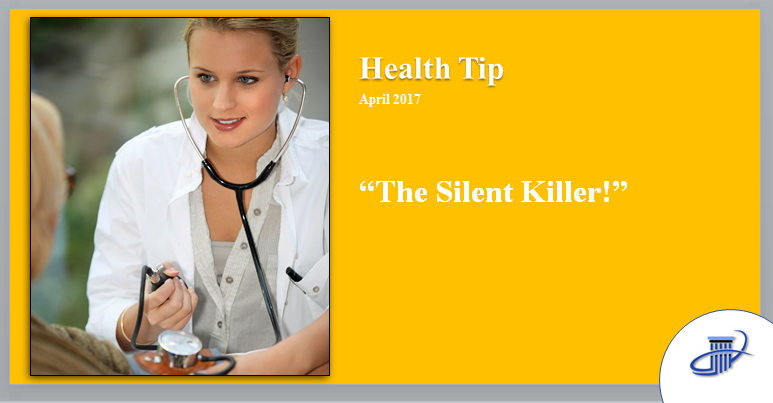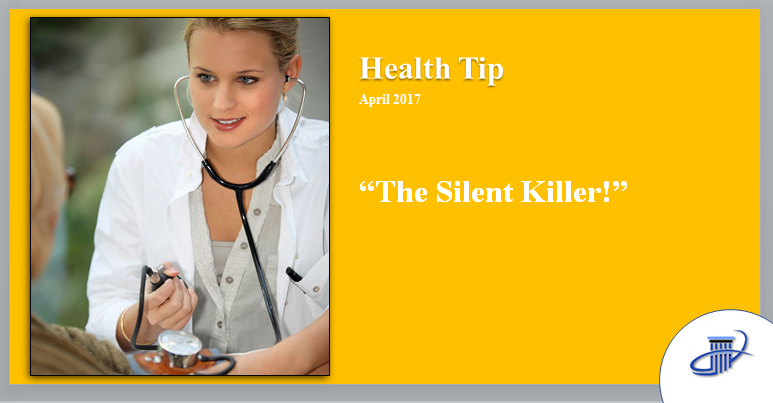Health Tip
April 2017Beware of the Silent Killer!
[spacer height=”02px”]
By Sharon Groves
[spacer height=”03px”]
What is this “silent killer”? It’s also known as High Blood Pressure because it has no noticeable symptoms. Nearly one-third of all American adults have it. This is when your blood pressure is higher than normal for an extended period of time.
[spacer height=”02px”]
Many people have this problem for years without knowing it until diagnosed by a doctor. If any symptoms occur, it is only when blood pressure suddenly spikes and is extreme enough to be considered a medical emergency. This is known as hypertensive crisis. Some symptoms are severe headache, severe anxiety, shortness of breath, and nosebleed. That is why frequent blood pressure monitoring is vital.
[spacer height=”02px”]
The exact cause is not known, however, heredity does play a part in this. Some causes and risk factors, like age and gender, cannot be controlled, but others like diet and exercise can be managed. Other risk factors are your ethnicity, being overweight or obese, family history, smoking, diet, and stress. Home remedies such as meditating, listening to soothing music or enjoying the companion-ship of a pet have been proven to reduce stress and anxiety.
[spacer height=”02px”]
Should I be worried? If left untreated, it can lead to a greater risk of stroke or heart attack.It can also result in major organ damage such as to your brain, heart, kidneys and even the small vessels in your eyes.
[spacer height=”02px”]
What the Numbers Mean… Systolic is the top number and Diastolic is the bottom number.
[spacer height=”02px”]
If your blood pressure is 120/80 or less, your blood pressure is normal.
[spacer height=”02px”]
If your blood pressure is between 120/80 and 140/90: You’re at risk for high blood pressure and have what is referred to as prehypertension. Lifestyle modifications are important and could be recommended by your doctor.
[spacer height=”02px”]
If your blood pressure is: 140 and above for systolic or 90 and above for diastolic, your blood pressure is high. Lifestyle modifications and high blood pressure medicines are very important and could be recommended by your doctor. This can be especially true if you have diabetes or chronic kidney disease.
[spacer height=”02px”]
If your blood pressure is 160 or higher over 100 or higher, you are in Stage 2 of HBP. If your numbers are 180 or higher over 110 or higher, you are in crisis!
[spacer height=”02px”]
So what can I do? You should take it seriously! Managing your high blood pressure should be part of an overall health program that also includes managing or preventing problems like diabetes, high cholesterol, preventing blood clots, making dietary changes, such as limiting salt, and lifestyle changes that include quitting smoking and increasing daily exercise. Best advice? Talk to your doctor.
[spacer height=”02px”]
The good news is, this is treatable… “if” you take it seriously. We live in beautiful Arizona with near-perfect weather, so get out, walk, bike, hike or anything that will get you exercising. Don’t forget your bottle of water. As the saying goes….
[spacer height=”02px”]
“Stop and smell the roses along the way.”


